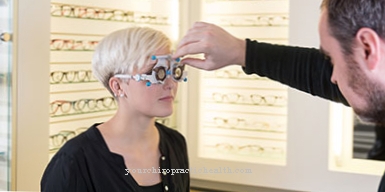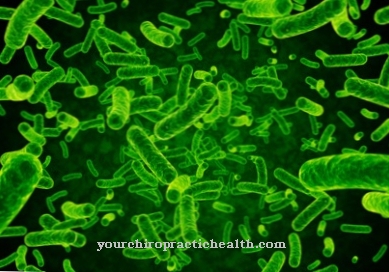At a Turner tooth it is a permanent tooth that has malformations and is characterized by defects in the tooth enamel (medical term enamel hypoplasia). The disease is named after the first person to describe the phenomenon, the English dentist J. G. Turner. He named the disease of the teeth as Turner's tooth.
What is a turner tooth?
Of the Turner tooth is characterized by damage or defects in the enamel of the teeth. In any case, the disease affects permanent teeth and not the milk teeth. So-called hypoplasia of the tooth enamel can result in deformities of the teeth and lead to the formation of a Turner tooth.
As a rule, a malformed tooth crown occurs in the typical clinical picture of Turner's tooth. Both the incisors and the molars (medical term premolars) are usually affected by these malformations. In addition, deformities can also appear at the roots of the teeth, whereby in most cases the incisors and premolars are also affected.
causes
There are various causes for the development of a Turner tooth, which must be clarified depending on the individual case.In many cases, a Turner tooth is formed because the previous milk tooth, which was in the place of the later Turner tooth, had a pus at the root of the tooth. This purulent inflammation is responsible for the fact that the permanent tooth has been damaged.
The cause of the ulcerated milk tooth is usually damage caused by caries attack on the tooth. Turner's tooth can also be caused by trauma to the milk tooth. Potential traumatic disorders that can arise in the course of tooth development are, for example, kinking of the tooth axis and the atrophy of the tooth system.
The subsequent infection leads to the deformity of the permanent tooth, as the inflammation damages the germ of the tooth. This has the consequence that the tooth development proceeds incorrectly. A Turner tooth occurs in around a quarter of all cases in which pus foci have formed at the roots of milk teeth.
In addition, periodontitis of the corresponding milk tooth can also be responsible for the development of the Turner tooth. It does not matter whether the periodontitis is localized at the tip of the tooth or in its interior. In both cases, the development of a Turner tooth can be favored.
Due to the inflammatory processes on the affected milk tooth, the tooth germ can be damaged as a result of the dissolution of the associated bone lamella. The bone lamella surrounds the developing tooth germ, which is indirectly damaged by the pressure resulting from the formation of edema. In addition, the tooth germ can also be damaged directly by the process of bone breakdown (medical term osteolysis) and promote the formation of a Turner tooth.
Symptoms, ailments & signs
A Turner tooth can cause various symptoms and complaints, which can vary depending on the location of the affected tooth, the extent of the deformity of the Turner tooth and the severity of the disease. As a rule, a Turner tooth can be seen with the naked eye and can therefore be easily recognized either by the patient concerned or by the treating dentist.
For example, clinical signs of a Turner tooth show up in areas that are discolored. Limited white spots up to brownish, opaque spots can appear on the tooth enamel. Hypoplasia can also occur in combination with tooth defects.
The possible defects can range from enamel defects to malformations on the anatomical crown shape of the tooth. In addition to deformation of the tooth crown and root, enamel defects can also occur, some of which are filled with a cement substance. The affected teeth may be reduced in size and the crowns may be yellowish to brownish in color.
Diagnosis & course of disease
A diagnosis of Turner's tooth should always be made by a dentist. A self-diagnosis is not appropriate, despite apparently clear symptoms, as the Turner tooth must be differentiated from other potential diseases of the teeth by a specialist. Turner's tooth symptoms are sometimes found in other diseases.
As part of the examination, the dentist checks the symptoms using a differential diagnosis in order to rule out other diseases such as amelogenesis imperfecta, dental fluorosis, tetracycline teeth, dilaceration, molar incisor hypomineralization or regional odontodysplasia.
Complications
A Turner tooth can cause various complaints and complications. Depending on the location of the affected tooth and the severity of the deformity, defects in the tooth enamel or further deformities of the teeth can occur. In severe cases, a Turner tooth causes deformities at the tooth root, which can be associated with inflammation and chronic pain.
Other complications depend on any underlying medical conditions. If, for example, amelogenesis imperfecta is the cause, caries and other dental diseases can occur in the further course. Treating a Turner tooth can also have adverse events. If a tooth crown is placed, there is a risk of injuring the neighboring gums.
The metals used can release harmful substances into the body and thereby cause long-term effects such as dental diseases or organ damage. Surgical intervention always carries the risk of injury and infection. Some patients experience temporary sensory disturbances after an operation on the tooth or suffer from phantom pain on the extracted tooth.
Medicines can also cause symptoms if they are overdosed or if the patient has an allergy. This can lead to symptoms of poisoning and symptoms such as headaches and gastrointestinal problems. Damage to the internal organs, especially the kidneys, liver and heart, cannot be ruled out.
When should you go to the doctor?
Treatment by a doctor is necessary for Turner's tooth. Only with correct treatment and, above all, early detection of the disease can further complications and complaints be prevented, so that the person affected should consult a doctor as soon as the first symptoms and signs of the disease appear. The earlier the Turner tooth is recognized, the better the further course of this disease will usually be.
A doctor should be consulted if the person concerned suffers from various malformations or malformations of the teeth. Discoloration can also indicate this disease and should be checked by a doctor. Defects in the tooth enamel itself often point to the disease, whereby the teeth are often yellow or brown and thus the aesthetics of the person affected are significantly reduced.
As a rule, the Turner tooth can be treated well by a dentist, so that a dentist should always be consulted first in the event of complaints.
Treatment & Therapy
Various treatment methods are available for the therapy of a Turner tooth, which are used depending on the severity of the deformity. In most cases, the deformities of the affected tooth can be corrected with the help of tooth abutments. In more difficult cases, a crowning of the Turner tooth or even an extraction must be considered.
In the event that the Turner tooth is a molar and does not cause any discomfort to the patient concerned, therapeutic measures can be dispensed with. However, the Turner tooth should undergo regular checks and examinations by the dentist to prevent possible complications. If the incisors are affected, cosmetic treatment is appropriate. In general, no therapy is required for mild enamel hypoplasias.
You can find your medication here
➔ Medicines against tartar and tooth discolorationprevention
As a preventive measure to prevent a Turner tooth, timely treatment of the affected milk tooth is possible. In more severe cases, an extraction of the inflamed milk tooth is also appropriate. This will help prevent potential germ damage that can cause Turner's tooth.
Aftercare
Follow-up care for Turner's tooth depends on the extent of the hypoplasia (underdevelopment) of the affected tooth and the resulting treatment. Treatment can be dispensed with if the underdeveloped tooth is a symptom-free molar tooth or if there are only minor defects in the tooth enamel.
Follow-up care then consists of regular control of the affected tooth as part of the usual prophylaxis. In this way, incipient complications can be identified quickly and treatment steps initiated. Larger deformities of a Turner tooth are treated by building up the teeth with composite or crowning. In the immediate follow-up care, the patient should observe the curing time of the composite of up to two days.
A short-term protection of the teeth by avoiding hard foods is advisable. During the chewing process, the patient should check whether the composite filling or the crown is correctly adjusted. If a reproduced tooth crown seems too high and interferes with biting against the opposite tooth, the dentist can carry out a correction.
This prevents the risk of temporomandibular joint pain due to incorrect loading. Regular dental checks are also important after this treatment. In terms of oral hygiene, the person being treated should pay particular attention to the crowned tooth. Crown margins are a risk zone for caries formation and should be cleaned carefully, also in the interdental spaces by using dental floss or interdental brushes.
You can do that yourself
If Turner teeth have been corrected by abutments, the patient should refrain from eating and drinking for a few hours. It is particularly important to avoid hot, cold, spicy, sour or sticky foods. If eating, it should be chewed with the teeth opposite the filling. Mineral water and gentle food may be consumed after the procedure.
A composite filling hardens within 24 to 48 hours. During this period, the teeth should be spared overall. In addition, the affected areas must be checked for abnormalities. If there are bumps on the filling, a visit to the dentist is recommended. Corresponding points can be felt with the tongue or by gently biting. If there are other problems such as discoloration or a strong sensitivity to the restored tooth appearance, a visit to the dentist is also recommended.
The teeth should be cared for very carefully after inserting a composite filling. At best, coffee, tea and wine are completely avoided, as these can cause discoloration of the fillings. Fluoride gels or pastes, which protect the teeth and strengthen the tooth enamel, are recommended. If these measures are followed, the Turner tooth should not cause any further discomfort.




.jpg)




















.jpg)

.jpg)
